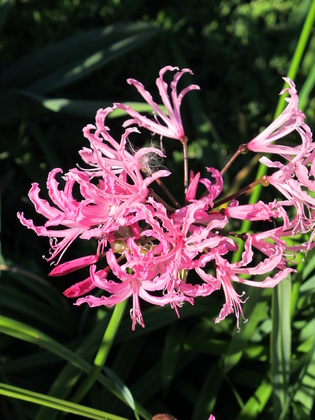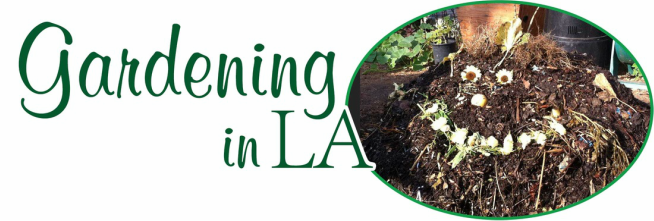 Pink nerine naturalize wonderfully in my garden after Fall bloom. Bloom time is extended because bulbs are planted in each of 17 levels up a ramp, with those getting the most sun blooming first, and the ones getting the least sun blooming last.
Pink nerine naturalize wonderfully in my garden after Fall bloom. Bloom time is extended because bulbs are planted in each of 17 levels up a ramp, with those getting the most sun blooming first, and the ones getting the least sun blooming last. No Bargains
Whether purchasing bulbs at a local vendor or through mailorder and online catalogs, there are bargains and then there are ways to waste your money in the name of economy. Waiting to purchase bulbs when they go on sale is a waste for two main reasons:
1. Bulbs that have been sitting in store displays have been slowly losing vitality because they’ve been too warm for too long.
2. Bulbs that have been overlooked by previous buyers are smaller and less vigorous.
Even at bargain prices, these will provide less than mediocre results. Better to spend less on premium-quality and get great results!
Which to Choose?
Choose big, plump bulbs, as these have the most stored food and will produce the largest and most numerous blooms over the longest period of time. They cost a bit more, but they'll provide a great deal more pleasure when they bloom.
Especially fragrant freesia cultivars include Athene, Allure, Demeter, Excelsior, Golden Wave, Mirabel, Pink Westlind, Snowdon, and Welkin.
If you like having blooms in the lawn, these are good for naturalizing, and the ripening foliage following bloom won't interfere with mowing the lawn: Chionodoxa, eranthis, muscari, ornithogalum, and puschkinia.
Don't forget to buy some bulbs just for indoor forcing color from Thanksgiving through January. Good choices include amaryllis, crocus, freesias, lily-of-the-valley, paperwhites, and tulips.
To Chill or Not to Chill?
Store the bulbs in a cool, well-ventilated area until you're ready to plant them.
Chill crocus, daffodil, hyacinth, narcissus, and tulip bulbs in a paper bag on the lowest shelf in the refrigerator -- at about 40 degrees -- for at six to eight weeks. Use a paper -- not plastic -- bag since the bulbs are alive and must breathe.
Keep chilling bulbs away from ripening fruit like bananas and apples, since the ethylene gas being released as they ripen will destroy the flower-developing hormones in the bulbs.
Planting
Enrich the soil where the bulbs are to be planted with compost, bone meal, and granite dust or wood ashes (but not from charcoal briquettes used in the barbecue, which contain harmful chemicals). Also, add some nitrogen, as it is easily washed from the soil by winter rains (hope, hope!), and bulbs need a small but continuous supply all winter long for strong growth of the foliage and the bloomstalk.
For a long-lasting spring display, plant some early, mid-season, and late-blooming bulbs every other week through mid-December, and again beginning in late January.
Depth of planting also affects when the bulbs will bloom. Shallower plantings will bloom sooner. Deeper plantings will bloom later. If you want everything to bloom for one spectacular display, plant the bulbs at the same time and at the same depth. If you prefer color over several months' time, plant bulbs every several weeks, and vary the planting depths each time you plant.
This makes them perfect for planting in containers.
Saffron Crocus
Plant autumn-blooming saffron crocus now. Each corm produces from one to three flowers, and about six corms should provide sufficient saffron -- just the three tiny red stamens in each bloom -- for each cooking or baking recipe.
Two Excellent Online Sources
For bulbs that don’t require special cooling attention because their climates of origin are closer to our own, there are two wonderful online resources:
- < > offers wonderfully thorough information and great variety of bulbs and tubers specifically for naturalizing in our Southern California gardens.< > categorizes its bulbs by origin -- Western US, South Africa, South America, and Other Parts of the World. For its blog of tips on cultivation and other information, go to www.thebulbmaven.typepad.com

 RSS Feed
RSS Feed